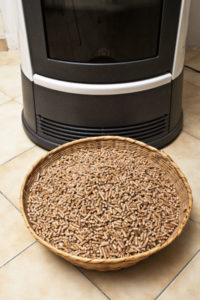Pellet stoves are a low-cost and eco-friendly alternative to wood stoves and fireplaces. Pellet stoves use wood byproducts from sawmills that burn cleaner than traditional wood. Most environmentalists consider pellet stoves carbon neutral because the pellets are created from trees that lived off carbon, so they cancel each other out. Pellet stoves can be used as a supplemental or stand alone heat source for your home depending on your needs. They are great for getting the look and feel of a traditional fireplace without all the hassles.
How Pellet Stoves Work
Pellet stoves feature a complex system of parts that allow it to operate very efficiently. Pellets are first loaded into the hopper, which stores them until the auger distributes them into the burn pot. From there, the burned ashes are moved to the ash pot, which needs to be cleaned periodically. The auger controls the temperature through the speed in which it delivers the pellets. The hopper can either be located on the top or bottom of the stove. Top-feed hoppers have less of a chance of allowing fire to burn back into the hopper, but have a higher chance of blocking airflow into the chamber. It is recommended to use a high-grade fuel that creates less ash with top-feed hoppers. Bottom-feed hoppers don’t have this issue because excess ash is moved to the ash pot more effectively, but they will require more frequent cleanings. Pellet stoves are powered by electricity, which means when the power goes out so does the stove. However, many come with backup batteries or can be attached to a generator to provide heat even when the power is out.
Advantages of Pellet Stoves
Pellet stoves have many advantages over wood-burning stoves and fireplaces. One advantage is the pellets themselves. Pellets come in bags that are easy to store and very affordable. Pellets stoves also create far less creosote, the extremely flammable subsistence found in chimneys, than regular fireplaces because of the low moisture content of the pellets. Another advantage of pellet stoves is that the desired temperature can be set and the auger will automatically feed the flames according to that temperature. This kind of temperature control means that properly ventilated and installed pellet stoves can be left unattended. Also, the stove is very small and can be installed as an insert to an existing fireplace or can stand on its own.
Buying Guide
There are many factors to consider when purchasing a pellet stove. One consideration is if you want a pellet stove with an automatic or manual ignition. Manual ignitions operate similar to traditional fireplaces, while an automatic starts with the push of a button. The size of the space you are wanting to heat will help you determine the amount of BTUs (British Thermal Units) you will need. According to the U.S. Department of Energy, a stove rated at 60,000 BTUs can heat an open-plan, 2,000-square-foot home. A stove rated at 42,000 BTUs can heat an open-plan, 1,300-square-foot space. The most important factor is to make sure you are purchasing from an authorized dealer. Dealers like us can not only help you pick the correct pellet stove for your home and heating needs, but we can also install proper ventilation and flooring materials needed to make your pellet stove safe. Give us a call and let us help you find the right pellet stove to fit your needs.



